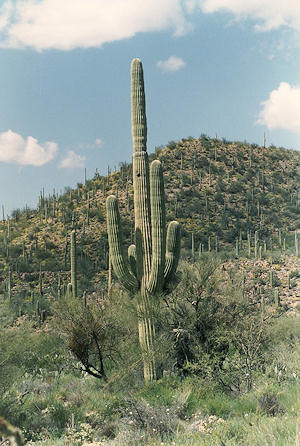I’ve just completed a couple of weeks doing talks on science and faith. This included a Lent talk to the church, but I’ve also been doing some talks in the Chantry – the local secondary school in Martley (having been kindly invited by the RE teacher, Mel Palmer).
I’ve started each of the talks with a brief autobiographical account of my involvement in the astronomical world. This is the background for why I strongly believe that Christians who speak about science should at least be scientifically literate. I therefore thought I’d give a brief summary here of my life as an astronomer, with a look at one of the projects I undertook.
I spent just over three years in Tucson, Arizona in the early 1990s, working as a postdoc at the University. I was massively fortunate to have this opportunity – one that I perhaps didn’t quite appreciate at the time as much as I should have done! While there I had about one hundred nights observing, mostly on Kitt Peak, which was then a leading observatory (but has since been overtaken by much bigger ones on higher mountains and in more remote places).

The Burrell-Schmidt telescope – a small, old scope which had fast optics, which was ideal for what I wanted to do.

The Ring Nebula as viewed by the Hubble Space Telescope. Note the star at the centre, which is becoming a white dwarf. Credit: NASA and The Hubble Heritage Team (STScI/AURA)
My main research interest was in white dwarfs and old planetary nebulae. When a star like the sun runs out of its nuclear fuel (thus, after it has burned all the hydrogen in its core, and then burned all of the helium), the core of the star collapses to become a white dwarf. Meanwhile, the outer layers lift off into space, for a while becoming a planetary nebula, one of the most beautiful sights in the sky. One example is the Ring Nebula (shown on the right), which is visible with binoculars, but is spectacular when seen with the Hubble Space Telescope; the star at the centre is becoming a white dwarf.
![The closest planetary nebula Sh 2-216, viewed with the Burrell-Schmidt in 1995, filtering for light from hydrogen (technically H-alpha]). Displayed to reveal the brighter stuff.](https://riverbankscribe.files.wordpress.com/2013/03/sh2-216_ha_east_inv_sm.jpg?w=584)
The closest planetary nebula Sh 2-216, viewed with the Burrell-Schmidt in 1995, filtering for light from hydrogen (technically H-alpha]). Displayed to reveal the brighter stuff – compare with the image below, which is displayed to show the fainter parts. The arrow marks the white dwarf.
Eventually, as the nebula expands, it becomes buffeted by the ambient wisps and clumps of interstellar gas, into which it eventually dissipates. The focus of my research was on those nebulae which were at this stage, of interacting with this interstellar material.
The research which probably gave me the most satisfaction was on the closest of all the planetary nebulae, which has the unglamorous name of Sh 2-216. I first became interested in it when I was studying white dwarfs at Leicester University – and was intrigued that the nebula has been so buffeted by the surrounding interstellar material that the white dwarf is no longer at the centre.
The nebula is very faint indeed, but spans about 1.6 degrees – far larger than any other then known. The telescope I used was ideal for this project, because it had a wide enough field-of-view for the task. I still had to produce a mosaic of images to cover it, but it was very doable.
It’s an indication of how much technology has improved in the 18 years since then that this nebula is now within the range of amateur observers, for whom it is a rewarding challenge. For example, this image is much prettier!
The problem with this research field is that the observations are easy but the theoretical modelling is spectacularly difficult – and it’s not quite as glitzy as quasars and distant galaxies! However an unexpected breakthrough came in 2008 as a result of the work of a team of radio astronomers, who were doing the Canadian Galactic Plane survey. They were very surprised to see it all – indeed, they only detected one other planetary nebula anywhere else in the sky – but the reason it was detectable was because of the interaction between the nebula and its surroundings. Ryan Ransom used the data to measure quantities such as the strength of the ambient magnetic field in the surroundings. However, he also emphasised the difficulties of deducing much more – largely due to the difficulties of the theoretical modelling. Nevertheless, the radio data is an important new angle that significantly improves the understanding of the nebula and its environment.


![The closest planetary nebula Sh 2-216, viewed with the Burrell-Schmidt in 1995, filtering for the light of ionised nitrogen (technically [N II]). Overexposed to reveal the faint stuff.](https://riverbankscribe.files.wordpress.com/2013/03/sh2-216_nii_med.jpg?w=584)